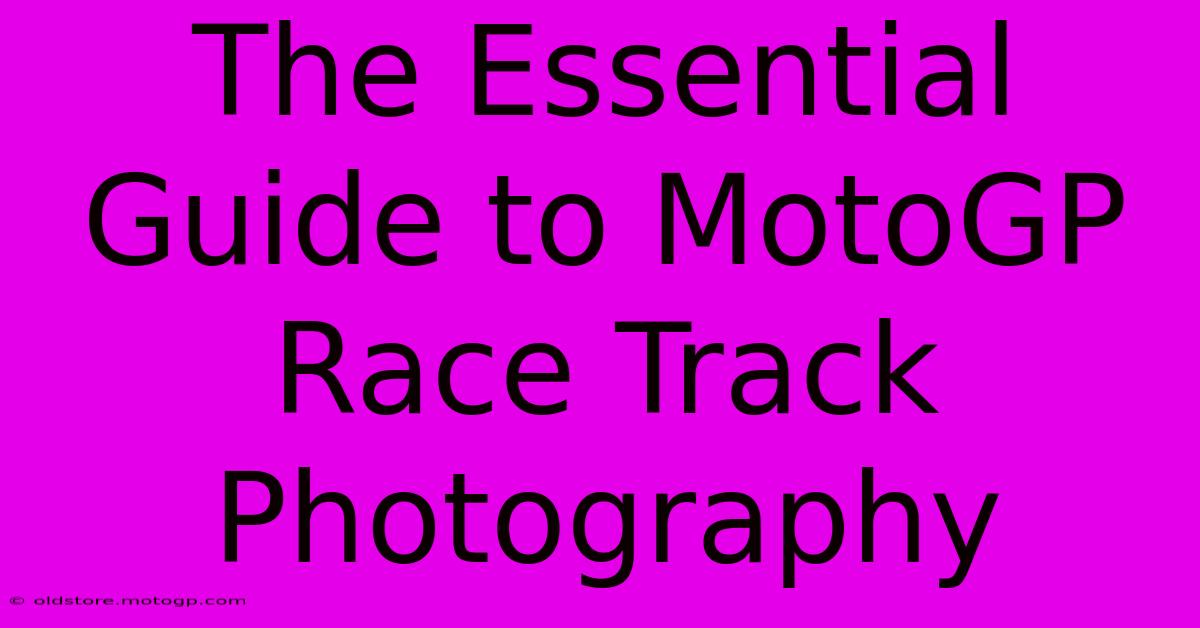The Essential Guide To MotoGP Race Track Photography

Table of Contents
The Essential Guide to MotoGP Race Track Photography
MotoGP. The roar of the engines, the blur of speed, the breathtaking skill of the riders – it's a spectacle that demands to be captured. But capturing the thrill of MotoGP on camera requires more than just pointing and shooting. This essential guide will equip you with the knowledge and techniques to take stunning MotoGP race track photography.
Gear Up for the Grid: Essential Equipment
Before you even think about framing that perfect shot, you need the right tools. Here's what you'll need for exceptional MotoGP photography:
1. The Camera:
- DSLR or Mirrorless: A high-quality DSLR or mirrorless camera with a fast autofocus system is crucial. The action is fast-paced, so speed and accuracy are paramount. Look for cameras with at least 7 frames per second (fps) continuous shooting capabilities.
- Consider a Backup: Technical failures can happen. Having a backup camera can save your day and prevent you from missing crucial moments.
2. Lenses: The Key to Great Shots
Lens choice significantly impacts your photography. Here's a breakdown:
- Telephoto Lenses: These are your workhorses. A 70-200mm f/2.8 or even a longer lens (100-400mm or more) will allow you to capture the riders up close, even from a distance. The wider aperture (f/2.8) is vital for capturing sharp images in low light and freezing the action.
- Wide-Angle Lens: A wide-angle lens (16-35mm) can be useful for capturing the overall atmosphere of the race, the crowd, and the broader context of the track.
3. Accessories:
- Fast Memory Cards: Use high-speed, large-capacity memory cards to avoid buffer clearing delays during continuous shooting. Consider cards with UHS-II or UHS-III speeds.
- Extra Batteries: MotoGP events are long. Extra batteries will prevent you from missing shots due to a depleted battery.
- Monopod or Tripod: While a tripod might be cumbersome, a monopod can provide stability, especially when using longer telephoto lenses.
- Remote Shutter Release: A remote shutter release minimizes camera shake, leading to sharper images.
Mastering the Art of MotoGP Photography: Techniques and Tips
Now that you have the gear, let's talk technique. Here are some crucial tips to elevate your MotoGP photography:
1. Understanding the Track and Schedule:
Familiarize yourself with the track layout and the race schedule. Knowing where the key overtaking points and straights are will allow you to position yourself strategically.
2. Finding the Perfect Vantage Point:
This is arguably the most important aspect. Research different viewing areas and consider factors like sun position, background distractions, and access to the track.
3. Autofocus Mastery:
- Continuous Autofocus (AF-C): This is essential for tracking the fast-moving bikes and riders. Experiment with different AF areas and tracking modes to find what works best for you.
- Back Button Focus: Consider using back-button focus to separate autofocus from the shutter release, allowing for more control.
4. Shutter Speed is King:
- Freeze the Action: You need a fast shutter speed to freeze the motion of the bikes. Start with at least 1/1000th of a second, adjusting as needed depending on the light conditions and your lens.
5. Aperture and ISO Settings:
- Aperture: Use a wide aperture (low f-number like f/2.8 or f/4) to blur the background and isolate the rider.
- ISO: Keep your ISO as low as possible to minimize noise. However, you might need to increase it in low light conditions.
6. Composition and Creativity:
- Leading Lines: Utilize the track itself as a leading line to draw the viewer's eye towards the riders.
- Rule of Thirds: Compose your shots using the rule of thirds for a more visually appealing image.
- Experiment with Angles: Don't just shoot from eye level; experiment with different angles to create dynamic and unique perspectives.
Post-Processing: Enhancing Your Masterpieces
Your work doesn't end when you press the shutter. Post-processing is crucial to enhance your images:
- Sharpness: Fine-tune sharpness in post-processing to achieve maximum detail.
- Color Correction: Adjust the white balance and color vibrancy to capture the true colors of the race.
- Cropping: Cropping can improve composition and remove unwanted elements from your photos.
Beyond the Basics: Taking Your MotoGP Photography Further
- Panning: Practice panning techniques to capture the speed and motion of the bikes while keeping them sharp.
- Shooting in RAW: Shooting in RAW format gives you greater flexibility during post-processing.
- Learn from the Pros: Study the work of professional MotoGP photographers to learn from their techniques and compositions.
By mastering these techniques and utilizing the right equipment, you’ll be well on your way to capturing unforgettable images of the electrifying world of MotoGP. Remember, practice makes perfect! So get out there, shoot, and experience the thrill of capturing the speed and excitement firsthand.

Thank you for visiting our website wich cover about The Essential Guide To MotoGP Race Track Photography. We hope the information provided has been useful to you. Feel free to contact us if you have any questions or need further assistance. See you next time and dont miss to bookmark.
Featured Posts
-
Breaking Barriers The Pursuit Of Top Speed In Moto Gp
Feb 20, 2025
-
Free Moto Gp Live Stream High Speed Action Free Access
Feb 20, 2025
-
Motorcycle Racing Rules And Regulations Competing Fairly And Safely
Feb 20, 2025
-
The Art Of Racing Mastering The Moto Gp Track
Feb 20, 2025
-
Experience The G Force Tnt Moto Gp
Feb 20, 2025
